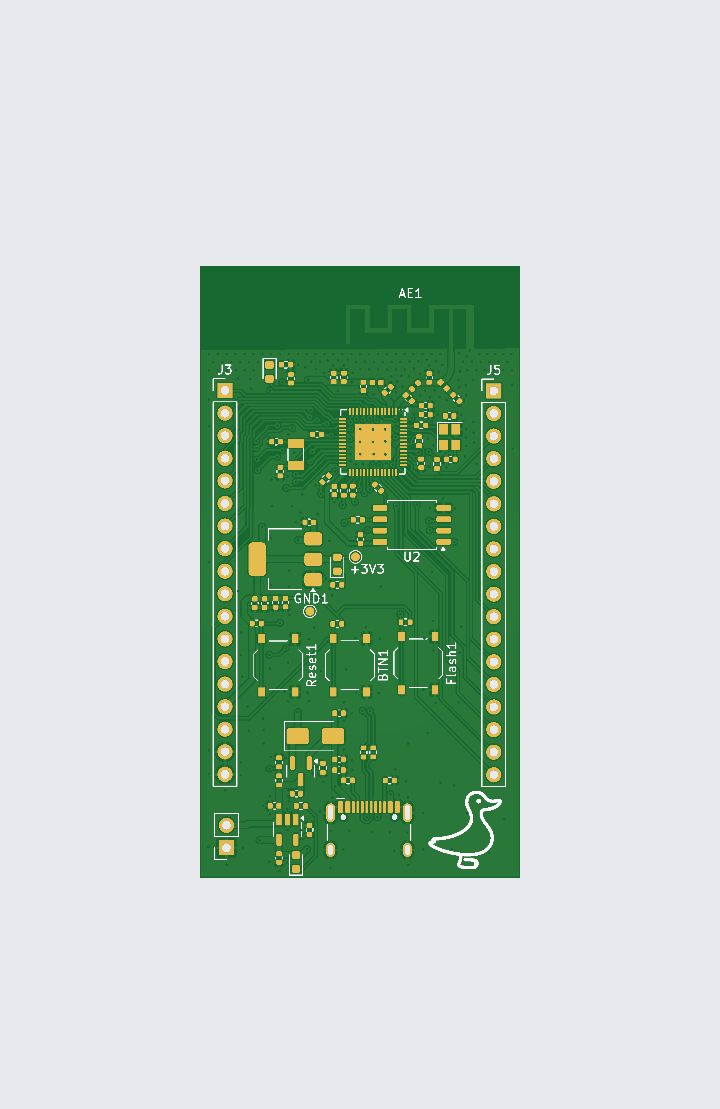Custom Devboard
This project is a custom-designed breakout board for the ESP32-S3 chip, created using KiCad 9. The board features native USB-C programming support, and includes an integrated Li-Ion battery charger.
Created by
![]() Jayadeep
Jayadeep
Tier 3
1 view
0 followers
Timeline
![]() Jayadeep
submitted Custom Devboard for review ago
Jayadeep
submitted Custom Devboard for review ago
![]() Jayadeep
added to the journal ago
Jayadeep
added to the journal ago
Custom Devboard
Custom Devboard

Project Overview:
This project involves designing a custom breakout board for the ESP32-S3 chip using KiCad 9. The goal is to create a compact and feature-rich development board that includes modern capabilities such as native USB-C programming support and an integrated Li-Ion battery charger. The board is designed to be flexible and easy to use for IoT and embedded systems projects that require wireless communication, low power consumption, and battery management.
The ESP32-S3 is a powerful microcontroller with built-in Wi-Fi and Bluetooth capabilities, ideal for projects like smart home devices, wearables, and sensor networks. Our breakout board will allow users to quickly prototype and develop applications using the chip, while also providing additional features like battery charging and USB-C connectivity.
Key Features:
ESP32-S3 Microcontroller: Features Bluetooth and Wi-Fi connectivity, optimized for low power operation and efficient processing.
USB-C Programming: Native support for USB-C for both power and data, simplifying the setup and providing a more modern interface.
Integrated Li-Ion Battery Charger: A built-in charging circuit allows users to charge a connected Li-Ion battery via USB-C, making the board more portable and self-sufficient.
Compact Design: A small, breadboard-compatible footprint makes it easy to incorporate into a wide range of prototypes and projects.
GPIO Access: Exposed pins for various I/O options, giving developers flexibility to connect sensors, actuators, and other peripherals.
Hardware Design:
The hardware design focuses on creating a robust, versatile, and easy-to-use breakout board for the ESP32-S3. Some important aspects include:
Power Circuit: The board supports USB-C power input, and a built-in Li-Ion battery charger with protection circuitry allows users to safely charge their battery.
Voltage Regulation: A stable 3.3V regulator ensures the ESP32-S3 receives the proper voltage. It can operate on power from USB-C or the connected battery.
Pinout: The ESP32-S3’s pins are brought out to headers for easy access, allowing developers to connect external peripherals and sensors.
Programming Interface: The USB-C interface serves as the programming and debugging port, allowing easy connection to the board without needing additional adapters.
PCB Design:
The PCB was designed in KiCad 9 to ensure a high-quality, professional layout. Key design elements include:
Schematic Design: The schematic diagram includes all the necessary components for USB-C power input, battery management, and connections to the ESP32-S3 chip. Care was taken to ensure minimal noise on power and signal lines for reliable performance.
Board Layout: The board was carefully routed to ensure efficient current distribution, signal integrity, and minimal interference between sensitive components. Ground planes and decoupling capacitors were added to ensure stable operation.
Layer Stack: The design utilizes a two-layer PCB with a solid ground plane to reduce electromagnetic interference (EMI) and improve the performance of the ESP32-S3’s wireless capabilities.
Testing and Debugging: Test pads were included for easy debugging and measurement of critical voltages and signals.
Challenges and Solutions:
USB-C Pinout: One challenge was managing the correct pinout for USB-C and ensuring compatibility with standard USB power and data lines. We referenced USB-C standards and made sure the data lines were routed properly.
Battery Management: Ensuring proper charging and battery protection circuitry was a critical design decision. We incorporated an integrated charging IC with overvoltage, undervoltage, and short-circuit protection.
Size and Form Factor: Since the board needed to be compact and breadboard-friendly, it required careful planning of component placement to avoid crowding while maintaining a practical layout for assembly.
Next Steps:
Prototype Testing: Once the first PCB is fabricated, we will test the ESP32-S3 breakout board with different power sources and peripherals. This will help us verify the charging circuit, USB-C functionality, and overall stability of the design.
Firmware Development: Initial firmware will focus on testing basic I/O functionality, Wi-Fi and Bluetooth connectivity, and battery charging.
Iteration and Optimization: Based on prototype testing, we may revise the design to address any issues, optimize routing, or add additional features.

![]() Nachu Thenappan 🚀
requested changes for Custom Devboard ago
Nachu Thenappan 🚀
requested changes for Custom Devboard ago
Hi, this is definitely not enough journaling for 1 project you need much more detailed journals in order to let this be approved.
![]() Jayadeep
submitted Custom Devboard for review ago
Jayadeep
submitted Custom Devboard for review ago
![]() Jay 🚀
requested changes for Custom Devboard ago
Jay 🚀
requested changes for Custom Devboard ago
Where are you getting the cart screen short? It's so expensive, devboard PCB was like 2$ for me, and you have to selfsoder, we wont fund PCBA
![]() Jayadeep
submitted Custom Devboard for review ago
Jayadeep
submitted Custom Devboard for review ago
![]() Jayadeep
added to the journal ago
Jayadeep
added to the journal ago
Custom Devboard
Custom Devboard using esp32
This project is a custom-designed breakout board for the ESP32-S3 chip, created using KiCad 9. The board features native USB-C programming support, and includes an integrated Li-Ion battery charger,
Hardware
Features -ESP32-S3 Microcontroller
-USB-C Port
Used for both power input and firmware flashing
-Li-Ion Battery Charging Circuit
Integrated charger IC with status indicators
Supports single-cell Li-Ion/LiPo batteries
-Compact Breakout Form Factor
All key GPIOs broken out!

![]() Jayadeep
started Custom Devboard ago
Jayadeep
started Custom Devboard ago